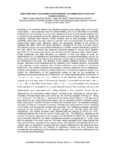Please use this identifier to cite or link to this item:
http://www.alice.cnptia.embrapa.br/alice/handle/doc/872896| Title: | Sunflower yield: adjustement of data means by the combination of ANOVA and Regression models. |
| Authors: | OLIVEIRA, M. C. N. de  CASTRO, C. de   OLIVEIRA, F. A. de   |
| Affiliation: | MARIA CRISTINA NEVES DE OLIVEIRA, CNPSO; CESAR DE CASTRO, CNPSO; FABIO ALVARES DE OLIVEIRA, CNPSO. |
| Date Issued: | 2010 |
| Citation: | In: INTERNATIONAL BIOMETRIC CONFERENCE, 25., 2010, Florianópolis. [Scientific programm.]. Florianópolis: UFSC : IBS, 2010. 1p. Poster Session, M41. CD-ROM. |
| Description: | Sunflower is an important oilseed crop. Besides producing high quality edible oil for human consumption, it also produces meal for animal feeding, and is an alternative for biodiesel production as well. Sunflower is a crop well adapted to several environmental conditions and is tolerant to low temperatures and to relatively short periods of water stress. In Brazil, the sunflower cultivated area reaches 75,000 hectares and its yield averages 1,460 kg/ha (CONAB). Much effort has been spent on research work at management of sunflower and consequently higher yield. Research efforts are specifically directed to the control of diseases and pests, which can cause defoliation, damages to the roots, and yield losses. The need for macro- and micronutrient fertilizations is another research demanding aspect of the crop. Within this context, two extremely important aspects in solving these research demands are: the appropriate agronomical planning and the adequate experimental design. These procedures will allow decisions on selection of size and shape of plots, on experimental unit, on qualitative and quantitative factors, on experimental design, and on the choice of the variables that influence the response and the ways of choosing and distributing the treatments in the plots. The selection of the suitable statistical methods, which allow precise estimates of the treatments and the reduction of the residual variance, uncontrolled in the planning, is also essential. One of these methods is the Analysis of Covariance (ANCOVA). This method combines the Analysis of Variance (ANOVA) and the Regression Analysis, and besides controlling the experimental error, it adjusts the treatment means, thus helping the interpretation of the experimental results as well as the comparison of regressions among several groups of treatments. The model representing this combination is :Yij = ? + ? i + ? j + ? (xij - x.. ) +? ij , where: Yij is the observed value of the response variable; ? is the mean value of the response variable; i ? is the effect of treatment I, with i = 1, 2,?, I; j ? is the effect of the block j, with j = 1,2,?, J; ? is the effect of the combined linear regression Yij as related to x; ij x is the observed value of the co-variable; and ij ? is the experimental error associated toYij, with ?ij ?N (0,?2 ) . The covariate should not be influenced by the treatments initially tested, maintaining the independence among them. Therefore, the treatments were: one control (0), and the P2O5 dosages of 40 kg ha-1, 80 kg ha-1, 120 kg ha-1, and 160 kg ha-1, applied to the sunflower hybrid Aguara 4. The experiment was carried out as a randomized block design, with six replications and the variables studied were: yield (kg ha-1) and the number of achenes per sunflower plant. The descriptive analysis indicated consistency in the tests concerning normality and independence of errors, additivity of the model, and homogeneity of treatments variances. The F statistics presented significant response for the treatments, for the response variable and covariate (5.48 and 4.93), respectively. The highest sunflower yield, obtained with the dosage of 120 kg ha-1 P2O5, statistically differed only from the control (Tukey p? 0, 05). The ANCOVA, adjusted by the number of achenes, reduced the error variance from 49,768.84 to 32,887.40. An interesting fact is that after ANCOVA, the effect of treatments became non-significant (F = 2.62), even with the reduction of the error variance. The mean values adjusted by the Tukey-Kramer test were reduced when compared to the original means. The interaction of treatment with the covariable was not significant, indicating that the angular coefficients for the treatments were similar. We concluded that the analysis of covariance reduces the error variance and indicates the real significance of the treatment effects and of the angular coefficients for the non-homogeneous treatments. |
| Thesagro: | Biometria |
| Type of Material: | Resumo em anais e proceedings |
| Access: | openAccess |
| Appears in Collections: | Resumo em anais de congresso (CNPSO)  |
Files in This Item:
| File | Description | Size | Format | |
|---|---|---|---|---|
| sunflower.mcno.pdf | 38.69 kB | Adobe PDF |  View/Open |









